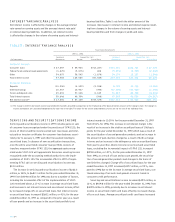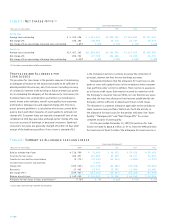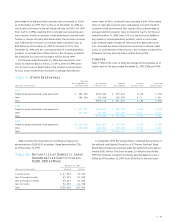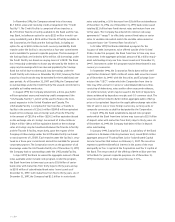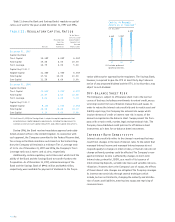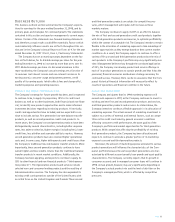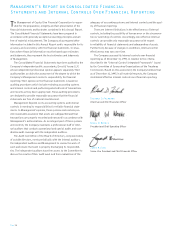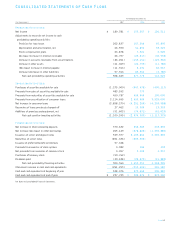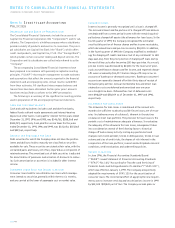Capital One 1997 Annual Report Download - page 36
Download and view the complete annual report
Please find page 36 of the 1997 Capital One annual report below. You can navigate through the pages in the report by either clicking on the pages listed below, or by using the keyword search tool below to find specific information within the annual report.
The Company has entered into swaps to effectively convert
certain of the interest rates on bank notes from fixed to variable.
The swaps, which had a notional amount totaling $450 million as of
December 31, 1997, will mature in 1998 and 2000 to coincide with
maturities of fixed bank notes. In 1997, the Company entered into
swaps with notional amounts totaling $450 million to effectively
offset the swaps described above with matching maturities and terms
which pay fixed and receive variable rates. As of December 31, 1997,
the variable rate payments on the original and offsetting swaps
were matched and will continue to offset each other through matu-
rity. As of December 31, 1997, the weighted average fixed rate
payment received on the original swaps was 7.39%, and the
weighted average fixed rate payment paid on the offsetting swaps
was 6.50%.
The Company has also entered into swaps to reduce the interest
rate sensitivity associated with securitizations.The swaps, which
had a notional amount totaling $591 million as of December 31,
1997, will mature in 1998 and 1999 to coincide with the final pay-
ments of a 1995 securitization. In 1997, the Company entered into
swaps with notional amounts totaling $591 million to effectively
offset the swaps described above with matching maturities and
terms which pay fixed and receive variable rates. As of December 31,
1997, the variable rate payments on the original and offsetting
swaps were matched and will continue to offset each other through
maturity. As of December 31, 1997, the weighted average fixed rate
payment received on the original swaps was 7.68%, and the
weighted average fixed rate payment paid on the offsetting swaps
was 6.52%.
Liquidity
Liquidity refers to the Company’s ability to meet its cash needs.The
Company meets its cash requirements by securitizing assets and
through issuing debt. As discussed in “Managed Consumer Loan
Portfolio,” a significant source of liquidity for the Company has
been the securitization of consumer loans. Maturity terms of the
existing securitizations vary from 1998 to 2004 and typically have
accumulation periods during which principal payments are aggre-
gated to make payments to investors. As payments on the loans are
accumulated for the participants in the securitization and are no
longer reinvested in new loans, the Company’s funding requirements
for such new loans increase accordingly.The occurrence of certain
events may cause the securitization transactions to amortize earlier
than scheduled which would accelerate the need for funding.
Table 13 shows the amounts of investor principal from securi-
tized consumer loans that will amortize or be otherwise paid over
the periods indicated based on outstanding securitized consumer
loans as of January 1, 1998. As of December 31, 1997 and 1996,
66% of the Company’s total managed loans were securitized.
As such loans amortize or are otherwise paid, the Company
believes that it can securitize consumer loans, purchase federal
funds and establish other funding sources to fund the amortization
or other payment of the securitizations in the future, although no
assurance can be given to that effect. Additionally, the Company
maintains a portfolio of high-quality securities such as U.S.Trea-
suries and other U.S. government obligations, commercial paper,
interest-bearing deposits with other banks, federal funds and other
cash equivalents in order to provide adequate liquidity and to meet
its ongoing cash needs. As of December 31, 1997, the Company had
$1.5 billion of such securities.
Liability liquidity is measured by the Company’s ability to obtain
borrowed funds in the financial markets in adequate amounts and at
favorable rates. As of December 31, 1997, the Company, the Bank
and the Savings Bank collectively had over $2.0 billion in unused
commitments under its credit facilities available for liquidity needs.
PAGE 34
Table 13: Securitizations—Scheduled Amortization Table
(Dollars in Thousands) 1998 1999 2000 2001 2002-2004
Balance at beginning of year $(9,369,328 $7,202,549 $(6,471,428 $(4,412,078 $ 872,790
Less repayment amounts (2,166,779) (731,121) (2,059,350) (3,539,288) (872,790)
Balance at end of year $(7,202,549 $6,471,428 $ 4,412,078 $(872,790 $ —


